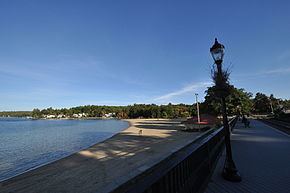Founded c. 9,000 BCE Excavation dates 1970s NRHP Reference # 75000120 | Architectural details Number of temples: Area 6 ha Added to NRHP 12 May 1975 | |
 | ||
Location Weirs Beach, New Hampshire, USA | ||
Aquadoctan top 5 facts
Aquadoctan was one of the largest known Native American villages in what is now the U.S. state of New Hampshire. In an area commonly known today as The Weirs (for the semi-permanent fishing weirs the Natives had built on the river), the village lay on the north bank of the Winnipesaukee River at the outlet of Lake Winnipesaukee in the Lakes Region of New Hampshire. The site is now in Weirs Beach, a summer resort and village of the city of Laconia. The village, whose archaeological remains extend for a half mile along the river and a quarter mile along the lake, has been documented through archaeological investigation to have a settlement history from 9,000 BCE to the late 17th century. The site is documented through colonial reports to be substantially abandoned in 1696, when most of New Hampshire's remaining Native population withdrew to join the Pequawket at present-day Fryeburg, Maine.
Contents
A 15-acre (6.1 ha) section of the village site was listed on the National Register of Historic Places in 1975.
